KIDS SHOWS AND MERCHANDIZING IN JAPAN
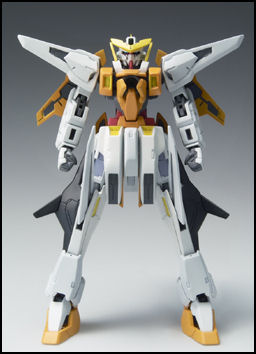
Gundam toy tie in
with TV show There are lots of shows for children with product and merchandise tie ins. Pokemon is the most famous. “Cinnamon Roll” was big in the mid 2000s with little kids, generating popular songs and dolls and hundreds of merchandise items. For a while, schoolbag, dolls and other “Sailor Moon” products brought in more than $250 million a year.
“Transformers” — cars and trucks that can transform into robots — ranks with Pokeman as one of the most lucrative media and merchandising succes stories. The phenomena had a complex beginning as toys in the United States and Japan and inspired the animated television series and the movies, including an animated film in 1986 and a big-budget blockbusters in 2007 and 2009. Some say it all began with the Japanese cartoon “Macross” (“Robotech” in the United States), about F-14 fighter that changed into robots.
Among the under six set “Tottoko Hamtaro” (“Little Hamsters, Big Adventures”) was all the rage in the early 2000s. These wide-eyed manga hamsters found their way on to a popular anime and a number of hit records and an array of products that rivaled Hello Kitty. The “hamustas” first appeared in Shogaku Ninensei (Second Grader) magazine to tie in with the popularity of hamsters among children. By 2003, the anime was shown in 15 countries, including Britain, South Korea, Thailand, the United States, Brazil, China and Spain. The characters also became very popular among cute-loving Japanese women in their 20s.
Websites and Resources

Anpaman Good Websites and Sources: Kids Web web-japan.org/kidsweb ; Anpanman ntv.co.jp/anpanman ; Anime News Network Report on Doraemon animenewsnetwork.com ; Time magazine article on Doraemon time.com/time ;Japan Hero on Ultraman japanhero.com/ultraman ; Official Pokemon Site pokemon.com/us ; Official One Piece site onepiece.viz.com
Links in this Website: MEDIA, RADIO, NEWSPAPERS AND TELEVISION IN JAPAN Factsanddetails.com/Japan ; TELEVISION PROGRAMS IN JAPAN Factsanddetails.com/Japan ; CHILDREN’s TELEVISION SHOWS IN JAPAN Factsanddetails.com/Japan ; INTERNET IN JAPAN Factsanddetails.com/Japan ; COMMUNICATIONS IN JAPAN Factsanddetails.com/Japan ; CELL PHONES IN JAPAN Factsanddetails.com/Japan ; USES OF CELL PHONES IN JAPAN Factsanddetails.com/Japan ;
Good Websites and Sources: Good Photos at Japan-Photo Archive japan-photo.de ; Japanese Newspapers and Media sabotenweb.com ;The Evolution of TV in Japan www.nhk.or.jp ; Media and Communications in Japan japanesestudies.org.uk ; Media Intimidation in Japan japanesestudies.org.uk ; Statistical Handbook of Japan Media Section stat.go.jp/english/data/handbook ; 2010 Edition stat.go.jp/english/data/nenkan ; News stat.go.jp
Japanese English-Language Newspapers: Daily Yomirui yomiuri.co.jp/dy ; Japan Times japantimes.co ; Asahi Shimbun with the International Herald Tribune asahi.com ; Mainichi Daily in English mdn.mainichi.jp ; Japanese Television Stations NHK nhk.or.jp ; Nippon Television Network (NTV) ntv.co.jp ; Fuji Network fujitv.co.jp/en ; TBS (Tokyo Broadcasting System) News (in Japanese) news.tbs.co.jp ; TV Asahi company.tv-asahi.co ; CNN on Japan topics.cnn.com ;
Radio Streaming Radio on DMOZ DMOZ ; DVDs Japanese, Chinese and Korean CDs and DVDs at Yes Asia yesasia.com ; Japanese, Chinese and Korean CDs and DVDs at Zoom Movie zoommovie.com ; CD Japan cdjapan.co.jp ;
Anpanman
The most popular show among two- and three-year-old is “Anpanman”, a cartoon character with a face that resembles a red-checked happy face button with a bozo nose.
Anpanman is bean-paste-stuffed bread roll super hero that fights giant germs. An “anpan” is a sweet roll with sweet bean paste. Anpanman's buddies include Kareepanman (Curry-bun-man), Shokupanman (White-bread-man) and Meronpanna-chan (sweet little melon bread). One of the primary villains is Baikinman (Bacteria-man).
Anpanman is such a kind, selfless creature he offers parts of his head to people that are hungry. There are hundreds of different Anpanman products, something that brings endless joy to toddlers running loose in toy stores and endless aggravation to their parents.
Doraemon
Another very popular cartoon features a fat, blue robot cat named “Doraemon”, who flies around the world with a roto-beanie "takecopter" on his head, and pulls magic tools out a pocket connected to the fifth dimension. In the show, Doraemon has come to the present time from the 22nd century to help his builder's grandfather — a nerdy, Charlie-Brown-like forth grader named Norbita — fend off bully attacks and get generally into shape.
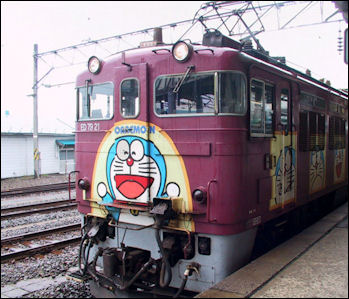
Doraemon at Aomori Station
Doraemon is often called Ding Dong outside of Japan. One of the most enduring animation characters in Asia, he first appeared on December 1, 1979 in Japanese comic book and was created by animator Fujio F. Fujiko, who died in 1996. Doraemon is known for pulling amazing number of “future gadgets” out of his pocket — such as the "takecopter" (bamboo helicopter), "super gloves" and the "dokodemo door," (anywhere door) that allows instantaneous travel to anywhere the user wishes — to extricate himself and Norbita from a range of scrapes and misadventures. Doraemon is afraid of mice. He is quite verbal and is constantly giving Norbita suggestions and advise on how to run his life.
Doraemon was among 25 Asians chosen by Time magazine as “Asia’s greatest living heros.” He was selected because he “inspired and cheered millions of children.” Doraemon is not well known in the United States but has a following in parts of Europe and Latin America. The show’s and the character’s popularity has been attributed to their ability to tap into the dreams and imagination of children while being sympathetic, engaging.
Doraemon comic books, originally aimed at elementary school students, take up 45 volumes and have sold more than 100 million copies in Japan. Millions more have been sold outside of Japan. A number of Doraemon products are available including numerous toys, cups and plates, and English-teaching materials. At its peak in the 1980s, the Doraemon anime televison drew a 30 percent rating series Doraemon is so famous the Vienna Choir Boys have recorded the theme song from his animation television and more than 660,000 people have accessed the website devoted to academic research on him.
The popularity of the “Doraemon” television show has declined. The rating for the television show was only 10 percent in 2003, due mainly to competition in his time slot from the a popular series with a black Labrador and his adventures in the Japan Alps. Ratings dropped further when that Doraemon was given a facelift and theme song and voices were changed, much to the disgust of his fans.
In 2010, that National Museum of Emerging Science in Tokyo hosted an exhibit called “Doraemon’s Scientific Future,” featuring real-life reversions of the gadgets he carries in his belt. Among them were the 75-kilogram, single-seat GEN H-4, the world’s smallest helicopter, a super glove that gives users a grip strength of 200 kilograms, and machines that instantly translate a number of languages (a nod to jelly used by Doraeomn that when consumed allows him to speak and understand any language).
Ultraman
Ultraman is one of the best known and enduring of all action creatures, not only in Japan but around the world. He has a robot-like head, glowing light bulbs for eyes, a skin tight silver and red suit and karate moves. He came from the Nebula M-78 to protect Earth and can enlarge to a 40-meter-tall version of himself to fight monsters. When he enlarges a colored timer on his chest begins to pulse after three minutes of activity to indicate that his energy is being depleted.
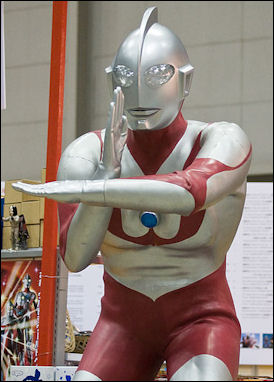
Ultraman Ultraman was created by special effects director Eiji Tsuburaya (1901-1970), who was largely responsible for creating Godzilla’s appearance and has been dubbed the “God of Special Effects.” Ultraman first appeared on television in 1966 in the “Ultraman Q”courtesy of Tsuburaya Productions and achieved an astounding 42.8 audience rating in 1967. This was followed by “Ultraman” (1966-67) and “Ultra Seven” (1967-68). In 2001, he was stills going strong in his 12th series’"Ultraman Cosmos."
Among the countries that Ultraman has appeared in are the United States, Spain, France, Thailand and China. Ultraman is very big in Thailand. He has tour around the country and appeared at Ultraman Millennium Shows in Bangkok. Rare Ultraman action figure sell for hundred of dollars a piece.
A 32-year-old fan of the show, told the Japan Times, Ultraman "taught me the meaning of justice and the importance of perseverance. When my parents tried to teach me how to behave, they often sounded pushy to me, but I was able to accept the hero's messages very naturally through the stories."
Explaining what Ultraman is all about an executive at Tsuburaya Productions told the Japan Times, "Many people want to interpret he stories in various ways. We just wanted to make high-quality entertainment that could be enjoyed by both children and adults. If there’s a message, it would be the importance of courage or the meaning of love."
Recent incarnations of Ultraman — “Ultraman Cosmos” (2001-02), “Ultraman Nexxus” (2004-05) and “Ultraman Mebius” (2006-07) — have not done so well. They were aired mainly in early morning or evening, which are not the best time slots for young children, the show’s primary audience. The series saved money by reusing old monster suits and using computer-generated sets instead of miniature sets.
Ultraman and Monsters
More than 1,300 monsters have appeared in the various Ultraman series. Famous ones include the coin-eater Kanegon, astronaut-turned-monster Jamira and “space dinosaur” Zetton, which defeated Ultraman. Gomora appeared in various Ultraman television series and went on to fight other monsters in the show “Ultra Galaxy: Dai Kaiju Batoru” which also features Red King and Eleking, other favorites.
Toru “Tohl” Narita (1929-2002) was the creator of many monsters on the show. His monsters included the giant-clawed Barutan Seijin, the striped Dada; and Kanegon. His began his career making monsters as part time staffer on the film “Godzilla” (1954) . He started working on the “Ultraman Q” series in 1966.
Like other superheros, Ultraman spends most of his time as a human. He only takes Ultraman form when monsters — like those who'd battle with Godzilla — appear. In his first metamorphosis as silver-and-blue Luna Moe he tries to calm the monster and convince him to go to a social monster sanctuary. If Ultraman and the monster decide to fight Ultraman changes into red Coruna Mode and attacks.
Ultraman's only limitation is that on earth he can only fight for only three minutes, with a blinking light on his chest warning him when his time is almost up. In very rare case he can’t manage to defeat his foe before his time runs out he rushes off to M-78 to recharge his power.
Japanese Tokusatsu Film Technique
Takashi Kondo wrote in the Yomiuri Shimbun, For decades, children have been enthralled by science fiction and superhero films and TV series, such as Godzilla, Ultraman, Gamera and Chikyu Boeigun (Global defense force), which are produced using "tokusatsu," a Japanese special effect that involves filming miniatures. Tokusatsu is being replaced by computer graphics, which means the filming technique using miniatures is in decline," Anno said. [Source: Takashi Kondo, Yomiuri Shimbun, July 6, 2012]
"The miniatures are only used when the movies and TV series are filmed," film director Hideaki Anno, curator of Tokusatsu--Special Effects Museum, Anno told thr Yomiuri Shimbun. "So they are not repaired when they break, and some are simply thrown away." Items include hero costumes, mechanical devices, and complex structures such as Tokyo Tower, the flying submarine battleship called "Goten," which appeared in the 1963 film Kaitei Gunkan (Undersea warship) and the aircraft "MAT Arrow No. 1" from the 1971 TV series Kaettekita Ultraman. The intricate designs and colors of the items is a major attraction.
Among Anno’s top five tokusatsu favorites is the original Godzilla movie of 1954. It was the first film to feature the iconic Japanese monster. Anno saw the movie just after he graduated from high school. He has praised the film as one of the greatest monster movies of all time. Unfortunately, none of the original Godzilla costumes were well preserved. The "Oxygen Destroyer," which appeared in the film as a fictional weapon of mass destruction designed to kill Godzilla, is one that survived.
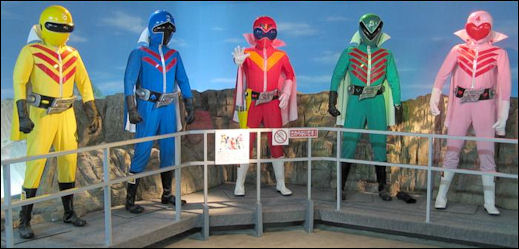
Sentai Goranger
Another Anno favorite comes from Mighty Jack, a science fiction espionage TV series in 1968 about a secret organization that uses the flying battleship "Mighty Jack" to fight evil, which Anno saw as a primary school student. The main attraction is the "Mighty Jack" itself, which Anno says is "extremely cool." Only 40 percent of the original battleship parts remained when the exhibition was conceived. However, it has been restored using the same techniques that were utilized to create the original.
His remaining three favorites are of the hugely popular TV Ultra series including Ultraman (1966), Ultra Seven (1967) and Kaettekita Ultraman (1971). Anno praises the series, saying, "the format of original Ultraman as a giant hero story was perfect," he said. There are numerous items on display, including an Ultraman figure used to film a flying scene, and a "color timer" attached to Ultraman's chest that shows when his energy level is depleted.
Ultraman Litigation
Tsuburaya Productions is currently embroiled in more than 60 lawsuit, including libel and damage cases, filed by Chaiyo Film company of Thailand in courts in Thailand, China and Japan. In the suits Somposte Saengduenchai — president of Chaiyo Film company and friend Eiji Tsuburay, the creator Ultraman — claims he promised the international rights to many of the old Ultraman series
The battle began in the mid 1990s when Saengduenchai suddenly produced a contract signed in 1976 between himself and Eji’s son Noburo Tsuburaya, the president of Tsuburaya Productions, that gave him rights commercially use nine early series, including “Ultraman” and “Ultraman Seven”, in any country for an unlimited time.
Saengduenchai said the contract was offered in lieu of profits that were promised him but not given for early Ultraman films he helped finance. In 2003 a Japanese court ruled in Saengduenchai’s favor giving him rights to commercially use the nine Ultraman series outside of Japan,
Pokemon
One of the most popular fads to come out of Japan has been “Pokemon”, a multimedia phenomena that include cards, video games, television shows and a merchandises. Inspired by a Nintendo game about catching and growing monsters, the Pokemon carton first appeared on Japanese television in April 1997 and later made its way to the United States and Europe, where it set off a card trading craze and eventually made its way to every country in the world, except for maybe North Korea.
“Pokemon” means "Pocket Monsters." Initially there were 151 characters, the most famous of which was Pikachu, a little, yellow, bunny-like creature. Others include Mew, Meowth and Caterpie.
As of the late 1990s, Pokemon had been broadcast in 65 countries and had been translated into more than 30 languages and was featured on the cover of Time.
See Separate Article POKEMON: HISTORY, ORIGIN AND CONTROVERSIES factsanddetails.com
One Piece
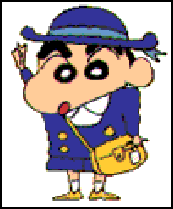
Shin-chan
In the early and mid 2000s, “One Piece” was the hottest anime and manga in Japan and one of the best-selling manga of all time. As of 2008 140 million copies had been sold. Volume 27 alone sold 2.63 million copies in its first printing alone. “One Piece”first appeared in 1997 in Shukan Shonen Jump, a weekly magazine for boys.
The main character is named Monkey D. Luffy. His main ambition is to become a great pirate and to obtain the One Piece, a treasure left by the legendary pirate Gold Roger. After eating a cursed Gum-Gum Fruit for dessert when he was small, Luffy gained the power to stretch his whole body like rubber. It made him, however, unable to swim — a mark against one who want to become a pirate. With his crew of Straw Hat pirates — which includes the navigator Nami and the swordsman Roronoa Zolo — Luff sails the world’s oceans in search of the legendary treasure, escaping from numerous scrapes with his courage, special power and good luck.
Conan and Shin-chan
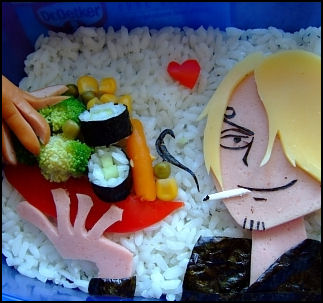
One Piece bento”Crayon Shin-chan” is sort of a Japanese version of “The Simpsons”. Shin-chan is little, obnoxious five-year-old, sort of like Bart Simpson. He enjoys using cheeky adult slang and mooning anyone who will look. He uses his short stature to peak up women’s skirt and his little mouth to make crass jokes and insult and publically humiliate his parents every chance he gets. As is true with Bart, Shinchan is very popular with irreverent kids of all ages and the bane of their parents. For a half dozen years in a row “Crayon Shin-chan” has been voted by Japan’s national PTA as the worst show for children.
“Crayon Shinchan” first appeared in 1990 three years after “The Simpsons” made their debut. Some regard Shin-chan as a Bart Simpson rip off. But there are really a lot difference between the two. Shin-chan is younger and if anything is more vulgar. He likes groping middle-aged women talk about genitalia, usually his own but frequently his mother’s. One if his favorite gags is taking his mother’s lipstick and drawing an elephant between his legs.
Yoshito Usai, the creator of Crayon Shinchon, was found dead below a cliff on Mount Arafune in Gunma Prefecture in 2009. It is believed he slipped while taking a photograph. His digital camera was found near his body and it contained picturers of a rock face which he is believed to have fallen from. The camera was on when it was was found. The detached strap, which appeared to have been pulled off the camera, was found attached to Usai’s wrist.
“Conan” is about a detective named Jimmy Kudo whose is poisoned by gangsters with a chemicals that shrinks him down in size and make him look like a child. To keep the bad guys from realizing he is still alive he adopts the name Conan Edogawa, a homage to the mystery writer Sir Conan Doyle. Conan has all of Jimmy’s skills and insight but because of his appearance is not taken seriously by the adult public. As a result he does his detective work through his sidekick, Richard Moore, a clueless, slacker detective. The plots are often very complex and implausible. The manga version “Meitantei Conan” runs to 60 manga volumes,
Mighty Morphin Power Rangers and the Billionaire Who Brought Them America
Haim Saban, a billionaire “former cartoon schlepper” who lives in Beverly Park and is a major political donor with protecting Israel being one of his main causes, initially got rich by bringing “Mighty Morphin Power Rangers” to America. In 1985, Saban returned from a trip to Japan with live-action footage in which five teen-agers become superheroes by donning spandex suits, Connie Bruck wrote in The New Yorker. “Shuki Levy wrote a screenplay and directed a short, titled “Bio-Man,” which combined American and Japanese film. “For years, Haim walked around with this cassette, and the general reaction was “This is the worst thing we’ve ever seen,” Levy said. [Source: Connie Bruck, The New Yorker, May 10, 2010]
“But in the early nineties Margaret Loesch, a veteran producer of children’s programming who was heading the Fox Kids Network, visited Saban’s office, looking for a new series. “I said, I want something adventurous, fun, silly,” she recalled. “It was like a light bulb went on in his eyes and he ran down the hallway. Two minutes later, he scooted back, holding out this cassette. “Darling, everybody thinks I’m crazy, but look at this!”
“Loesch loved “Bio-Man,” and eventually prevailed over network executives who worried about the series’ production quality and its violence. In 1993, “Mighty Morphin Power Rangers” became an overnight hit. In Saban’s hands, the series — reviled by critics but adored by young boys — became fodder for something bigger. “Haim was one of the original guys who understood how to create a franchise, built off one of these TV shows, into a merchandising tsunami,” Jeffrey Katzenberg, who was the chairman of the Walt Disney Studios at the time, said.” Following the success of “Power Rangers,” Saban and his wife bought the four-acre parcel in Beverly Park.
“Saban is not given to modest ambitions, Bruck wrote in 2010. “Sixty-five years old, with a broad, dynamic countenance and slicked-down wavy black hair, he is known in Los Angeles as the man who brought the Mighty Morphin Power Rangers from Japan to America; the chairman and part owner of Univision, the nation’s leading Spanish-language media company; a staunch supporter of Israel (he has dual citizenship); and one of the largest individual donors to the Democratic Party. “Haim is a force of nature,” his friend Barry Meyer, the chairman and C.E.O. of Warner Bros., said. As a youth in Israel, Saban attended an agricultural boarding school where, he says, immigrants like his parents sent children they could not afford to feed. When he was expelled for being a troublemaker, he began attending a night school, where the principal told him, “You’re not cut out for academic studies; you’re cut out for making money.” The prediction seemed to come true in 2001, when Rupert Murdoch and Saban sold their joint venture, Fox Family Worldwide, to Michael Eisner, the C.E.O. of Disney: Saban made one and a half billion dollars. It was — and still is, he points out — the biggest cash transaction by an individual in the history of Hollywood. In March, Forbes estimated his net worth at $3.3 billion.”
Gotochi Heroes
Makoto Tanaka and Takashi Oki wrote in the Yomiuri Shimbun: Super heroes known as "gotochi" or "local" heroes that star on regional TV programs have become immensely popular. These defenders of justice, who are sometimes based on local folklore, protect the peace, while on a crusade to promote their beloved homeland. While these characters traditionally enjoy a large following in local areas, some are now achieving nationwide fame. One example is "Ryujin Mabuyer," a warrior from Okinawa Prefecture who is the lead character in a film showing in cinemas across the nation. [Source: Makoto Tanaka and Takashi Oki, Yomiuri Shimbun, February 10, 2012]
So what made this gotochi hero so successful? Ryujin Mabuyer hails from Niraikanai, which means utopia in the Okinawan language. His first name, Ryujin, refers to the god of the mythological Ryukyu Kingdom of Okinawa and his surname, Mabuyer, means "soul" in the local dialect. The TV program, named after its leading hero, was first aired in Okinawa in October 2008 by RBC based in Naha. It features a timid young man who discovers that the soul of the ryujin resides within him.
Mabuyer fights against the Majimun, a vicious corps trying to collect the legendary Mabui (soul) Stones that contain Okinawan souls, such as the one named "Nuchi du Takara" (Life is a treasure). He is joined by sidekick Ryujin Ganasea, who represents a dragon god. The program became so popular that it is now syndicated nationally. It has aired for three series and hit a record high viewing rate of 17.6 percent.
Last year, more than 260 events featuring the gotochi heroes were held throughout the prefecture. Actors who star in the gotochi program use these events to interact directly with their fans.Gotochi heroes often wear modern, stylish costumes that are somehow significant to local people. Mabuyer's spectacular outfit is based on a mythological Okinawan shisa, which is a traditional guardian against evil, while Ganasea's costume represents a dragon.
The marketing drive behind Mabuyer is symptomatic of struggling local TV networks, which have been forced to secure revenue through nonbroadcasting means. They face an industrywide problem of falling profits from advertisements and therefore share similar interests in creating new streams of income.
Different Gotochi Heroes
Chojin Neiga (ABS based in Akita): "Chojin" means "super god" and "neiga" is derived from a famous line "Naguko wa inega" (Are there any crying children?), uttered by Namahage, an ogre who appears in a traditional festival in Akita Prefecture. The costume's shoulder protectors are modeled after a broad-bladed carving knife wielded by the ogre, and the knee pads look like wooden bucklers. The katakana character "a" for Akita is written on the belt.
Hojin Yatsurugi (Chiba TV): "Hojin" refers to a phoenix god, while "Yatsurugi" was taken from Yatsurugi-Hachiman Shrine in Kisarazu, Chiba Prefecture. The hero is based on a phoenix on the portable palanquin that sits at the shrine. Yatsurugi's head is modeled after the protective headpiece of a warrior.
Karakuri Samurai Sessha 1 (TV Shizuoka): Shizuoka is where the first shogun of the Tokugawa shogunate, Tokugawa Ieyasu (1542-1616), lived in his youth and after retiring. The name reflects the program producers' hope that the hero is the "strongest samurai warrior." "Karakuri" comes from karakuri ningyo, an elaborate mechanical doll made mainly during the Edo period (1603-1867), and "sessha" is a polite way to say "I," which was mainly used by samurai.
Tetsujin Gan Raiza (TV Iwate): "Tetsujin" is a god of steel, while "gan" is another reading of the kanji "iwa" used for Iwate Prefecture. The prefecture is famous for its traditional ironware. "Raiza" refers to "riser," a name reflecting the hope that the sun will again rise for people affected by the Great East Japan Earthquake. The hero has a sun symbol on its forehead, ironware for its shoulders, the kanji of "iwa" on its back, and a depiction of drum for the local Sansa dance in the center of its chest plate.
Satsuma Kenshi Hayato (Kagoshima TV): Kagoshima Prefecture went by the name Satsuma during the Edo period. "Kenshi" means swordsman and "hayato" refers to people who lived in the Kagoshima region. The costume has black elements to represent local specialities of black pork and black vinegar. The headpiece's crest is in the shape of the prefecture.
Other Japanese Children’s Shows
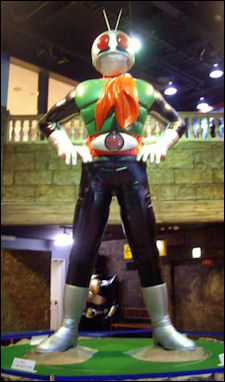
Kamen Rider Domo-kun, a puppet animation monster originally created in 1998 as a mascot to promote NHK’s satellite broadcasts was expanded into a morning children’s show with a caste of characters that included Usajii, the wise rabbit, and Ta-cha, a girl weasel. The characters have become very popular around the world, and have been shown in 115 countries.
“Kamen Rider” — featuring a grasshopper-faced, kung-fu-kicking super hero — is one of Japan's enduring children’s television show and best known pop culture icons. Kevin Short wrote in the Daily Yomiuri, This saga began in a 1971 TV series, when scientist and motorcycle racer Takeshi Hongo was kidnapped by the evil genius Shocker, who planned to transform him into a grasshopper monster. Hongo escaped, and with the help of friends used his transformational powers to combat a never-ending series of destructive kaiju monsters sent forth by Shocker. Over the past 40 years, successive generations of masked grasshopper heroes have continued to thrill small children and adult fans alike.”
Sailor Moon was very popular as a manga and anime for a while. It features “giggly, shopoholic schoolgirls dressed sailor-style schoolgirl uniforms who become saviors of the world.” Created by Naoko Takeuchi in a manga entitled “Pretty Guardian Sailor Moon”, it was turned into a popular anime that found a big audience in Europe and North America and ignited Sailor Moon mania in the 1990s. The story is basically about insiders and outsiders and being accepted into the group. For a while school bags, dolls and other “Sailor Moon” products brought in more than $250 million a year.
Image Sources: 1) xorsyst blog 2) Ray Kinnae 3) Goods from Japan 4) Japan Zone ; 5) YouTube
Text Sources: New York Times, Washington Post, Los Angeles Times, Daily Yomiuri, Times of London, Japan National Tourist Organization (JNTO), National Geographic, The New Yorker, Time, Newsweek, Reuters, AP, Lonely Planet Guides, Compton’s Encyclopedia and various books and other publications.
Last updated January 2013
